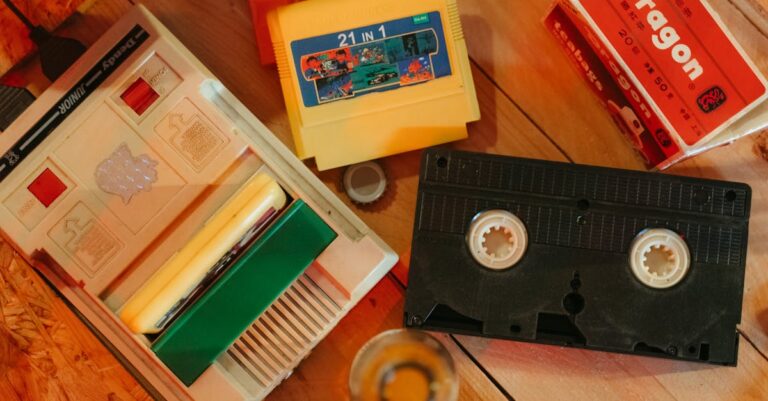Remember the days when we blew on cartridges, hoping they would work? Old video games aren’t just pixels on a screen: they’re our childhood memories and adventures packed into bytes. In this text, we’ll jump into the nostalgic world of classic video games, exploring how they shaped our lives, and how they continue to influence modern gaming. Grab your controller (or a snack) as we take this delightful trip down memory lane.
Old Video Games
The 1970s and 1980s marked the beginning of what we now fondly call the Golden Age of Video Games. This era introduced arcade games, with titles like Pong, and paved the way for home consoles. We witnessed the birth of the infamous Atari 2600, which brought gaming into our living rooms like never before. During this time, gaming transformed from a niche hobby into a cultural phenomenon. As we crowded around those bulky screens, we were not just playing games: we were part of a revolutionary movement.
Legends were born during this period. Games like Space Invaders sparked a worldwide craze. Suddenly, high scores became the currency of bragging rights among friends. Our weekend plans often revolved around who could beat that impossible level or set a new record. The excitement was palpable, and the magic of gaming began to intertwine with our daily lives.
Iconic Consoles That Shaped Gaming History
When we think of iconic consoles, the Nintendo Entertainment System (NES) often springs to mind. This beauty kicked off the golden age of console gaming and brought beloved franchises into our homes. Super Mario Bros. not only introduced us to an adorable plumber but also revolutionized platform gaming. The NES taught us that it was okay to fail and try again, turning failure into a quirky badge of honor.
Let’s not forget the Sega Genesis either, with its fast-paced gameplay and titles like Sonic the Hedgehog, offering fierce competition to Nintendo. Each console had its quirks and charm, and we, the gamers, were their loyal subjects. Each new release sparked a frenzy, leading us to camp out at stores just to get our hands on the latest innovation. What a time to be alive.
Classic Games That Defined Childhoods
Ah, the classic games. Titles such as The Legend of Zelda, Tetris, and Pac-Man are engraved not only in gaming history but also in our hearts. We spent countless hours exploring dungeons in Hyrule or trying to hit the highest score on Tetris. These games weren’t just entertainment: they were storytelling at its finest. They taught us about adventure, friendship, and the occasional heartbreak when we lost a hard-fought level.
Consider how many friendships blossomed over Mario Kart races, with each victory celebrated and each defeat shared with laughter. We often reminisce about those epic landlines beckoning us to dial into friends’ houses to challenge them. Those gaming sessions left us with lasting memories, like that time we accidentally knocked the family TV off the stand with an ill-fated jump in Super Mario.
The Evolution of Game Design and Technology
As we shifted into the 90s and 2000s, the evolution of game design became evident. Graphics improved dramatically, allowing for more immersive experiences. 3D graphics took center stage, and game developers began prioritizing storytelling along with gameplay mechanics. Titles like Final Fantasy VII brought narratives that resonated deeply with us, tackling themes of love, sacrifice, and friendship in a way that simple pixels once could not.
Meanwhile, the rise of the internet introduced multiplayer gaming, allowing us to join forces with friends (or rivals) from across the globe. We weren’t just playing in isolation anymore: we were part of vibrant communities. This shift propelled gaming into a connected future, steering it into the multiplayer phenomena we see today.
Nostalgia and Its Impact on Modern Gaming
Let’s talk about nostalgia. It has a funny way of sneaking up on us. As we investigate into the world of modern gaming, we can see remnants of those pixelated wonders we adored. Remakes and remasters of old classics like Final Fantasy VII and Sonic the Hedgehog flood the market, reminding us of our roots. We often find ourselves captivated by these revived adventures, cherishing the chance to share them with a new generation.
Modern games frequently weave retro aesthetics and gameplay into their designs, creating a charming blend ideal for both new and old players. This nostalgia not only keeps us attached to our screens but also fosters conversations across generations, bridging the gap between gaming eras.
Preserving Old Video Games for Future Generations
As we treasure these memories, it’s vital we consider the preservation of old video games. Many classics risk fading into obscurity as technology evolves and consoles become obsolete. Emulators allow us to play these cherished games on modern devices, but what happens when the hardware becomes too advanced?
Organizations and collectors are diligently working to archive these titles, ensuring that future generations can experience the joy we once felt. Preservation is not solely about maintaining the games themselves but also safeguarding the culture that surrounds them. From online communities (like those that relive the magic of 8-bit graphics) to dedicated preservation projects, the spirit of old video games is alive and insistently relevant.




